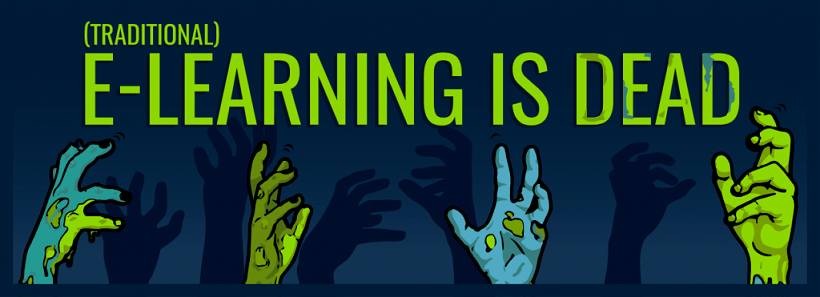Instructor-Led Training Isn't Dead: Should You Implement It In Corporate Training?
To paraphrase Mark Twain, the demise of Instructor-Led Training has been greatly exaggerated. Sure, eLearning is by far the preferred training structure for Learning and Development professionals. But there's still a place in a modern learning strategy for in-person training.
Instructor-Led Training is a deceptively broad term. While it's usually considered the traditional way of training and learning—in a classroom, with a teacher and students—it goes beyond that. Digital tools allow instructors to reach trainees through new and innovative ways. So included under the ILT umbrella are digital workshops and webinars. An argument could even be made for the ask-me-anything format as a form of Instructor-Led Training.
In short, the form is fairly dynamic even if it is a more traditional teaching method.
Of course, new techniques and methods for reaching learners come out all the time. It's easy to not consider Instructor-Led Training on the same level as something like, say, a Snapchat microlearning video.
The trick here is how to figure out how Instructor-Led Training can fit within the workflow of your learners.
The Modern Workflow
So, what is the current workflow of a typical employee? And how does L&D fit into that schedule? According to research from Bersin [1], a typical employee has all of 1% of their workweek—about 24 minutes—to work on professional development and skills training.
In that same research, Bersin notes that more than 80% of companies consider their business complex and challenging for employees. It just makes sense that employees of complex businesses should have more than half an hour each week to stay on top of the latest techniques and developments in their industry.
The kind of learning done by the businesses Bersin studied generally fall into 2 categories: in-the-moment technical answers and higher-level skills training. Translated into buzzwords: microlearning and macrolearning.
As you might suspect, microlearning consists of quick pieces of information. Think along the lines of reference material for technical, specific tasks. The information is typically indexed and searchable so an employee can find it in their precise of need. It's unlikely they'll commit the knowledge contained within microlearning pieces to their long-term memory. But those microlearning pieces are usually the type of information that isn't essential to the employee's daily tasks.
Macrolearning is what happens when you're learning a brand new skill. It tends to take a big effort on the part of the employee—the sort of thing that can take up the majority of those 24 minutes per week the average worker has to learn and grow.
Employees have about half an hour each week to train. Their training fits into 2 categories, both of which can be done online at a learner's own pace and convenience. How does Instructor-Led Training fit in with all this?
True Learning Takes Time
First, let's consider the fact that we, as humans, forget things pretty quickly. A psychologist named Hermann Ebbinghaus in the 1800s figured out that people forget new information exponentially over the course of 30 days, which he showed through what's now called the Ebbinghaus Forgetting Curve [2].
Only through practice and repetition can people truly remember a new skill or bit of information. Think of it akin to "on the job skills," Bersin writes [3]. Each day, there are certain tasks you do, some of which you hadn't done in previous positions. Over time those new tasks become familiar. Through repetition, eventually, you can coast through daily obligations and focus on more complex or abstract challenges.
This is where Instructor-Led Training fits into a modern learning strategy.
Let's say you arrange for an expert to come in and teach your learners some new technique. Having an in-person learning session ensures that learners carve out an appropriate amount of time to pick up the new skill.
Instead of a one-and-done training session—which, historically, Instructor-Led Training can sometimes be—the expert instructor uses eLearning tools to follow up once a week or so. Learners review the material, each time committing a little more knowledge to memory until they can effectively bring that new technology into their daily work.
This approach is called "Spaced Learning" [4], and it's gaining traction among L&D professionals. Basically, it's a teaching technique built off of Ebbinghaus's research. Learners dive back into the material at regular intervals for reinforcement of concepts or to pick up more nuanced applications of a given skill.
And the approach has a successful track record. Organizations such as Verus Global use Instructor-Led Training paired with regular eLearning refreshers to train leaders in a range of industries, from the Fortune 500 company Procter & Gamble to the nonprofit Habitat for Humanity.
It's easy to forget or discount Instructor-Led Training when seemingly every month the market gets a new technology that allows you to reach learners in innovative, novel ways. But you can bolster the effectiveness of your L&D strategy if you can figure out a way to pair successful teaching strategies of the past with the tools of today.
References:
- A New Paradigm For Corporate Training: Learning In The Flow of Work
- Don't Forget the Ebbinghaus Forgetting Curve
- The Disruption of Digital Learning: Ten Things We Have Learned
- Watch Out, Corporate Learning: Here Comes Disruption









